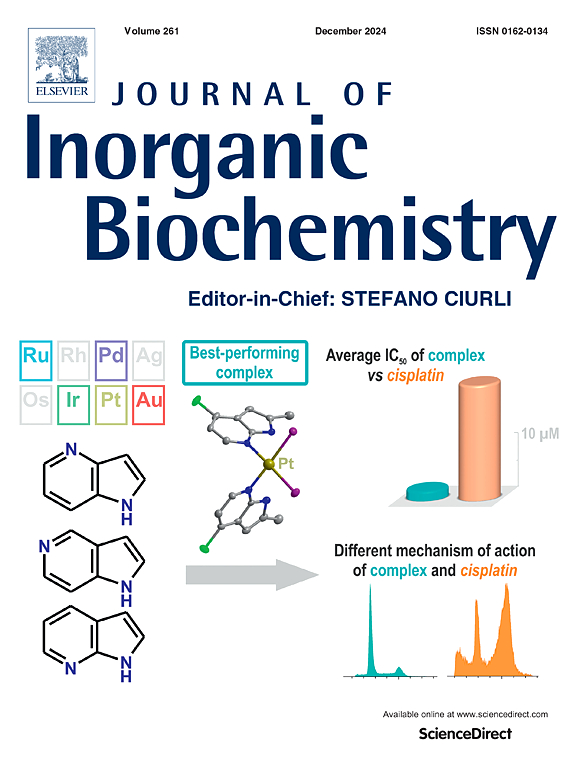Microbiological applications of the saccharinatecopper(II) complex (Cu-Sac)
IF 3.2
2区 化学
Q2 BIOCHEMISTRY & MOLECULAR BIOLOGY
引用次数: 0
Abstract
The tetraaqua-bis(saccharinato)copper(II) dihydrate complex (Cu-Sac) was synthesized, structurally characterized by single-crystal X-ray diffraction, and tested for antioxidant and antimicrobial activity. In this complex, deprotonated saccharin ligands coordinate monodentate via nitrogen in a trans configuration to copper, with four water molecules also bound. Its distorted octahedral geometry fits the formula [M(Sac)2(H2O)4]·2H2O. The Cu-Sac complex showed good antioxidant efficacy in DPPH and hydrogen peroxide scavenging assays and was effective against ten microorganisms in both pellet and solution forms. Notably, this study also assessed the use of the pigment in commercial white paint at 10 % and 20 % concentrations. MIC data indicated that the complex exhibits broad-spectrum antimicrobial activity, showing efficacy against Gram-negative and Gram-positive bacterial strains, and fungicidal activity against yeast strains. The copper saccharinate paint showed promising results in the disk diffusion test, producing inhibition zones of 27.50 ± 4.0 mm for P. mirabilis, exceeding the inhibition zones observed with standard antibiotics. An increase in the concentration of the complex in the paint was also shown to result in greater antibacterial efficacy. The activity index obtained for the paint samples showed good results, with the Cu-Sac 20 % sample being particularly noteworthy, especially against the S. epidermidis and E. faecium strains, with indices ≥1. These findings suggest that the Cu-Sac complex has potential as an antimicrobial pigment or surface-applied antibiotic agent, indicating promising prospects for industrial applications.

糖化铜(II)配合物(Cu-Sac)的微生物学应用
合成了四水双(糖精)铜(II)二水配合物(Cu-Sac),用单晶x射线衍射对其结构进行了表征,并进行了抗氧化和抗菌活性测试。在这个配合物中,去质子化的糖精配体通过氮以反式构型与铜单齿配位,同时还有四个水分子结合。其扭曲的八面体几何符合公式[M(Sac)2(H2O)4]·2H2O。Cu-Sac配合物在DPPH和过氧化氢清除实验中显示出良好的抗氧化效果,并且在颗粒和溶液形式下对10种微生物都有效。值得注意的是,本研究还评估了10%和20%浓度下商用白色涂料中颜料的使用情况。MIC数据表明,该复合物具有广谱抗菌活性,对革兰氏阴性菌和革兰氏阳性菌均有效,对酵母菌均有杀真菌活性。糖化铜涂料在圆盘扩散试验中表现出良好的效果,对P. mirabilis的抑制范围为27.50±4.0 mm,超过了标准抗生素的抑制范围。涂料中复合物浓度的增加也显示出更大的抗菌效果。涂料样品的活性指数均较好,其中20% Cu-Sac样品对表皮葡萄球菌和粪肠杆菌的活性指数均≥1。这些结果表明,Cu-Sac配合物具有作为抗菌色素或表面应用抗生素的潜力,具有良好的工业应用前景。
本文章由计算机程序翻译,如有差异,请以英文原文为准。
求助全文
约1分钟内获得全文
求助全文
来源期刊

Journal of Inorganic Biochemistry
生物-生化与分子生物学
CiteScore
7.00
自引率
10.30%
发文量
336
审稿时长
41 days
期刊介绍:
The Journal of Inorganic Biochemistry is an established international forum for research in all aspects of Biological Inorganic Chemistry. Original papers of a high scientific level are published in the form of Articles (full length papers), Short Communications, Focused Reviews and Bioinorganic Methods. Topics include: the chemistry, structure and function of metalloenzymes; the interaction of inorganic ions and molecules with proteins and nucleic acids; the synthesis and properties of coordination complexes of biological interest including both structural and functional model systems; the function of metal- containing systems in the regulation of gene expression; the role of metals in medicine; the application of spectroscopic methods to determine the structure of metallobiomolecules; the preparation and characterization of metal-based biomaterials; and related systems. The emphasis of the Journal is on the structure and mechanism of action of metallobiomolecules.
 求助内容:
求助内容: 应助结果提醒方式:
应助结果提醒方式:


